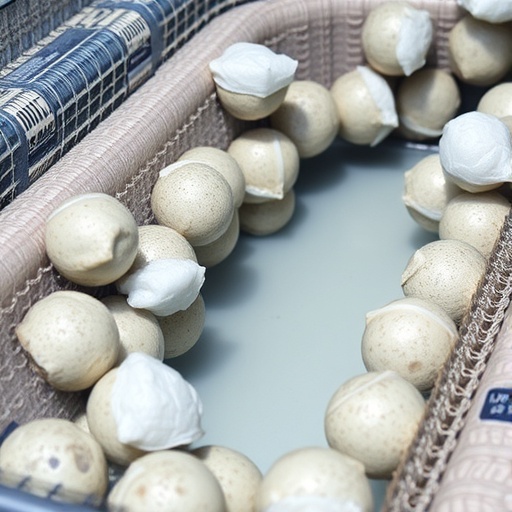When you squeeze shampoo from a bottle, the texture is just right—neither too watery to slip off your hands nor too gelatinous to spread. This texture owes its charm to specialized polymers known as viscosifiers, integral components that engineer the perfect balance of thickness and flow in countless consumer products, from shampoos and detergents to cosmetics. These polymers ensure that formulations remain stable, ingredients suspended and homogeneously distributed during use, delivering a consistent, enjoyable experience. Yet, the fate of these polymers once they cascade down our drains and enter the wastewater system remains an arcane puzzle, one now commanding critical scientific inquiry.
At the forefront of unraveling this mystery is Professor Xuanhong Cheng, a leading figure in bioengineering and materials science at Lehigh University’s P.C. Rossin College of Engineering and Applied Science. Cheng’s pioneering research focuses on the intersection of polymer science and microbial ecology—a frontier exploring how the polymers embedded in household products interact with the complex microbial communities resident in wastewater treatment plants. These microbial consortia are vital actors in sewage processing, responsible for degrading organic matter. However, their capacity to metabolize synthetic viscosifying polymers remains largely uncharted territory, posing challenges to both environmental safety and the future design of biodegradable materials.
The biological breakdown of polymers in wastewater environments involves a cascade of biochemical interactions wherein bacteria secrete enzymes capable of cleaving polymeric chains. Cheng’s research project, notably supported by a three-year GOALI (Grant Opportunities for Academic Liaison with Industry) award from the National Science Foundation, is a collaborative effort with Dow Inc., harnessing cross-sector expertise to dissect these complex mechanisms. Their goal is to systematically map the biodegradation pathways of water-soluble cellulose derivatives—a class of polymers widely utilized for their viscosity-enhancing properties. This endeavor promises to illuminate how polymer architecture dictates susceptibility to enzymatic attack and microbial assimilation.
Central to the methodology is an intricate experimental design that monitors microbe-polymer dynamics in meticulously controlled bioreactors. By inoculating polymer solutions with diverse microbial strains, Cheng’s team tracks microbial growth kinetics, metabolic activity, and the generation of secondary breakdown products. These metabolites can profoundly influence the microbial community structure and biodegradation efficiency, either serving as nutrients that amplify degradation potential or as inhibitors that stall the process. The ability to quantify these nuanced interactions empowers the team to decode the molecular choreography underlying polymer digestion.
A fascinating dimension of Cheng’s inquiry is the investigation into synergistic effects within microbial consortia. Preliminary findings suggest that mixed microbial communities may outperform monocultures in polymer degradation, possibly due to complementary enzymatic repertoires and cooperative metabolic exchanges. Exploiting such synergy could inform the design of synthetic microbial consortia tailored for wastewater treatment applications, optimizing polymer removal. This bioengineering approach has transformative implications, potentially enabling treatment facilities to proactively reduce polymer-associated contamination prior to effluent release into natural waterways.
In parallel with environmental remediation objectives, the research emphasizes the converse—a detailed understanding of complete polymer degradation chemistry to guide the rational design of next-generation viscosifiers. Materials scientists could employ these insights to engineer polymers with enhanced biodegradability, balancing functional performance with ecological compatibility. Such advances would represent a significant leap toward sustainable product cycles, mitigating the environmental footprint of everyday consumer goods.
Beyond technical achievements, the project embodies an educational mission. Cheng actively mentors undergraduate researchers, fostering a new generation of scientists versed in interdisciplinary approaches spanning chemistry, microbiology, and environmental engineering. This experiential learning paradigm imbues students with critical skills in experimental design, analytical methods, and scientific communication—preparing them to tackle pressing bioenvironmental challenges with innovative technologies.
The implications of this research are manifold. Wastewater treatment plants, traditionally designed to remove solids and reduce biochemical oxygen demand, stand at the cusp of integrating advanced microbial management strategies inspired by Cheng’s findings. Enhanced polymer degradation could curtail polymer accumulation in sludge and effluent, alleviating downstream ecological impacts such as disrupted microbial communities in receiving waters or bioaccumulation in aquatic organisms. Moreover, understanding polymer-microbe interactions at a molecular level advances fundamental microbial ecology, with potential ripple effects into bioprocessing, bioremediation, and synthetic biology.
Cheng’s collaborative model exemplifies how academia and industry can unite to confront complex environmental issues. By combining foundational research with industrial contingencies—such as product formulation constraints and scalability requirements—the project ensures that scientific breakthroughs translate effectively into real-world solutions. This cross-pollination accelerates innovation processes, aligning scientific discovery with practical, scalable environmental technologies.
The project’s multifaceted approach—integrating polymer chemistry, microbial enzymology, and ecological dynamics—illustrates the potency of convergent sciences in addressing environmental challenges. It invites a reimagination of polymer utilization, from a perspective that holistically encompasses lifecycle impacts, biodegradability, and ecosystem compatibility. As society intensifies efforts toward sustainability, research endeavors like Cheng’s become pivotal guides, steering innovations that harmonize material utility with environmental stewardship.
In the global context, polymer pollution in aquatic environments is an emerging concern, with widespread implications for water quality and biodiversity. Studies such as Cheng’s are thus timely, aligning with broader initiatives targeting microplastics and polymeric contaminants. The nuanced understanding of polymer degradation pathways contributes to the broader narrative of sustainable materials management, offering pathways to mitigate anthropogenic environmental burdens.
Ultimately, the unfolding story of polymers in wastewater is not merely one of chemical and biological interactions but also a testament to the intricate interplay between human technology and natural systems. Cheng’s work encapsulates this dialogue, charting a course toward materials that integrate seamlessly into environmental cycles, minimizing harm and fostering regeneration. Such endeavors herald a future where engineered materials echo ecological principles, underscoring the vital role of informed scientific stewardship in shaping sustainable futures.
Subject of Research: Interaction and biodegradation of water-soluble cellulose derivative polymers by microbial communities in wastewater treatment environments.
Article Title: Unraveling the Microbial Breakdown of Viscosifying Polymers for Sustainable Wastewater Treatment
News Publication Date: Not specified
Web References:
- Professor Xuanhong Cheng Profile
- NSF Award Abstract (2501450)
- Lehigh University Institute for Functional Materials and Devices
Image Credits: Lehigh University
Keywords
Polymers, Materials Science, Chemical Compounds, Polymer Engineering, Water Resources, Sewage, Wastewater, Microbiology, Microorganisms, Viscosity




